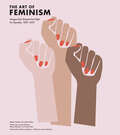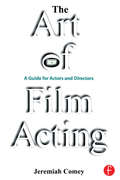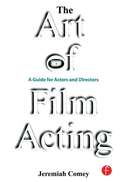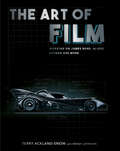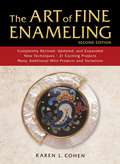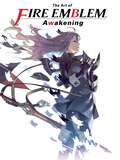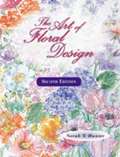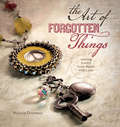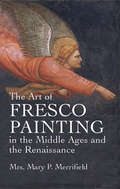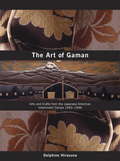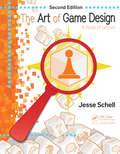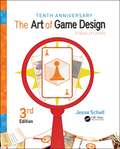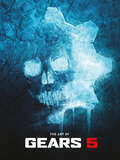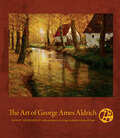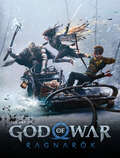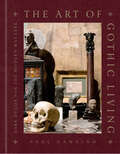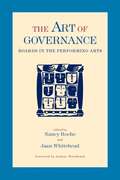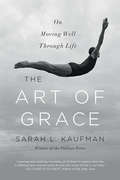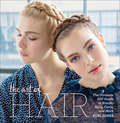- Table View
- List View
The Art of Feminism: Images that Shaped the Fight for Equality, 1857–2017
by Lucinda Gosling Amy Tobin Hilary RobinsonA survey of feminist art from suffrage posters to The Dinner Party and beyond: “Lavishly produced images . . . indispensable to scholars, critics and artists.” —Art MonthlyOnce again, women are on the march. And since its inception in the nineteenth century, the women’s movement has harnessed the power of images to transmit messages of social change and equality to the world.From highlighting the posters of the Suffrage Atelier, through the radical art of Judy Chicago and Carrie Mae Weems, to the cutting-edge work of Sethembile Msezane and Andrea Bowers, this comprehensive international survey traces the way feminists have shaped visual arts and media throughout history.Featuring more than 350 works of art, illustration, photography, performance, and graphic design—along with essays examining the legacy of the radical canon—this rich volume showcases the vibrancy of the feminist aesthetic over the past century and a half.
The Art of Film Acting: A Guide For Actors and Directors
by Jeremiah ComeyThis guide for actors and directors develops a valid method for training performers to act from their core--whether they are cold reading, auditioning, or performing for film or television. This book teaches actors how to achieve and respond to believable and honest emotions before the camera, and it maintains that the key to a successful performance lies in how the actors relate to one another and to the circumstances. Exercises, including script examples, throughout the book give readers an easy resource for practicing the principles outlined. The Art of Film Acting applies a classic stage acting method (Stanislavsky) to the more intimate medium of performing before a camera, teaching readers to experience an emotion rather than to indicate it.
The Art of Film Acting: A Guide for Actors and Directors
by Jeremiah ComeyThis book teaches actors how to achieve and respond to believable and honest emotions before the camera, and it maintains that the key to a successful performance lies in how the actors relate to one another and to the circumstances.
The Art of Film: Working on James Bond, Aliens, Batman and More
by Terry Ackland-Snow Wendy LaybournThere is no substitute for experience. I’ve had the privilege and honour to have worked alongside Terry Ackland-Snow for many years. Not only is he a prince among men and a close friend, he is also the design equivalent of Lionel Messi when it comes to creating a world and an environment for actors to do our stuff.TRobson Green‘Tim Burton came in and commented, “Great, but how do they get in the car? There aren’t any doors!” Sadly, I hadn’t thought of that.’What do On Her Majesty’s Secret Service, 2001: A Space Odyssey and The Great Muppet Caper have in common?Terry Ackland-Snow worked on them, that’s what.In The Art of Film, Terry lifts the lid on his extraordinary career, from being held hostage by a wannabe film crew in Jamaica to forgetting to add doors to the Batmobile. It is an insight into a lifetime of working in the film industry, mixing the amusing anecdotes with revelations about just how the magic in these movies was created. With over 200 images, including set sketches and design plans, this is a book no film aficionado should be without!
The Art of Fine Enameling
by Karen L. CohenThe most comprehensive book of enameling and enameling techniques has been completely revised to bring you this essential new reference.The wonderful world of enameling—fusing glass to metal under high-temperature conditions-- is diverse! Practically anything made from enamel-friendly metal can be enameled, from vases to jewelry to buttons to metal mesh and solid forms. In the first edition, published in 2002, Cohen explored this world as it was then, but so much knowledge has been gained in the last 17 years that it was definitely time for an update!Every chapter and project has been completely reviewed, revised, and updated; it&’s a whole new book, and one you will want in your reference library. The look and organization is updated, 15 years of experience has been added, about half the projects have changed, and two types of mini-projects to expand your learning experience are included. In addition, each project has a gallery of the work of other artists working in the same technique, to give a view of other ways a technique can look and be used. Classic techniques such as champlevé, cloisonné, and plique-à-jour each have projects, as do newer approaches such as the use of graphite pencil and enameling on steel—21 project lessons in all. And you will find the extensive troubleshooting chapter indispensable.**Silver Award Winner in Foreword Reviews Indie Awards in Hobbies & Home, 2019
The Art of Fire Emblem: Awakening
by VariousThe Art of Fire Emblem Awakening contains an in-depth, behind-the-scenes look at the smash-hit 3DS game, from beautifully illustrated renditions of your favorite characters, to storyboards for in-game events, character designs, weapon designs, character profiles, and the entirety of the script with every possible branch of dialogue! Relive some of the most poignant moments of the game, or see what might have been if you had made different in-game decisions with the Art of Fire Emblem Awakening!
The Art of Floral Design (2nd Edition)
by Norah T. HunterThe Art of Floral Design, second edition is a textbook designed to take the student from basic to advanced floral design techniques. With a well-balanced presentation of theory and practice this textbook sets the standard for teaching floral design techniques. Topics covered include the principles and mechanics of flower arranging, basic flower anatomy, as well as arrangement styles for a variety of special occasions. Updated to reflect the latest concepts and practices, this new second edition will place students at the forefront of floral design.
The Art of Floral Design (Agriculture Ser.)
by Norah HunterNIMAC-sourced textbook <P><P>Start your career in floral design with the 3rd Edition of THE ART OF FLORAL DESIGN! Newly-expanded and updated, the book introduces you to the full range of floral design techniques, from basic to advanced, with vivid photographs, colorful illustrations, and easy-to-understand descriptions. THE ART OF FLORAL DESIGN, 3rd Edition balances theory with practice, covering the history of design, artistic elements, floral anatomy, and nomenclature, along with techniques, tools, and specialties. Much more than a design book, THE ART OF FLORAL DESIGN, 3rd Edition prepares you for the real business world with discussions on distribution, marketing, advertising, and the other industry-specific issues you need to know for success in the field.
The Art of Fluid Animation
by Jos StamThis book presents techniques for creating fluid-like animations with no required advanced physics and mathematical skills. It describes how to create fluid animations like water, smoke, fire, and explosions through computer code in a fun manner. It includes a historical background of the computation of fluids as well as concepts that drive fluid animations, and also provides computer code that readers can download and run on several platforms to create their own programs using fluid animation.
The Art of Forgotten Things: Creating Jewelry from Objects with A Past
by Melanie DoermanDiscover a masterpiece that gives new life to found objects in The Art of Forgotten Things. Imagine necklaces and bracelets using one-of-a-kind components that hint at fragments of stories that exist only in the mind, evoking a mysterious past. Author Melanie Doerman will teach you how to take exquisitemementoes from history and make them into meaningful works of wearable art.The Art of Forgotten Things offers a brilliant new take on expressing your story within a jewelry design. Melanie shows how to create delicate beaded frames, clasps, nets, and components with seed beads and combine them with mixed-media elements for jewelry with an evocative look and feel. You'll also find an extensive techniques section that includes instructions for flat and tubular peyote, right-angle weave, bead netting, bead embroidery, and picot edges and fringes; basic jewelry techniques such as wire wrapping; mixed-media techniques such as foiling; and additional embellishment. Detailed step-by-step instructions are provided for each project.You'll learn about various types of beads used in the book's projects, from tiny seed beads to crystals, pressed glass, pearls, and more, as well as other materials, tools, and "treasures" that make each creation unique.In addition, Melanie explores using readily available materials and items that you might already have in your collection, along with directions for locating more unusual or vintage items. The Art of Forgotten Things is truly a one-of-a-kind masterpiece for all imaginative jewelry artists.
The Art of Fresco Painting in the Middle Ages and the Renaissance
by Mary MerrifieldKnown for its durability, a fresco painting is created in "sections" on freshly laid wet plaster, allowing the painter to comprehensively portray the subject and execute designs with ease. As both the paint and plaster dry, they become completely fused. Highly popular during the late-thirteenth to the mid-sixteenth centuries, fresco painting was almost a lost art by the time this book was first published in 1846. This volume, by a recognized authority in the field, was highly influential in reintroducing fresco painting to public attention. In addition to translating descriptions of painting methods used by such masters as Alberti, Cennini, Vasari, Borghini, Pozzo, and Pacheco, the author also interprets passages from rare manuscripts on the causes of fresco destruction and how to retouch, repair, and clean these works of art. Curators and art historians will find this classic reference work of immense importance and interest.
The Art of Frozen 2
by Jessica JuliusThrough never-before-seen development art, character sketches, storyboards, and color scripts, The Art of Frozen 2 gives fans a front-row view of the vast creative effort behind the much-anticipated sequel to Frozen. Filled with gorgeous four-color images and fascinating facts and details from the production team, it's the ultimate insider's look.Copyright ©2019 Disney Enterprises, Inc. All Rights Reserved
The Art of Gaman
by Kit Hinrichs Delphine Hirasuna Terry HeffernanIn 1942, Executive Order 9066 mandated the incarceration of 110,000 Japanese Americans, including men, women, children, the elderly, and the infirm, for the duration of the war. Allowed only what they could carry, they were given just a few days to settle their affairs and report to assembly centers. Businesses were lost, personal property was stolen or vandalized, and lives were shattered. The Japanese word gaman means "enduring what seems unbearable with dignity and grace. "Imprisoned in remote camps surrounded by barbed wire and guarded by soldiers with machine guns, the internees sought courage and solace in art. Using found materials at first and later what they could order by catalog, they whittled and carved, painted and etched, stitched and crocheted. What they created is a celebration of the nobility of the human spirit under adversity. THE ART OF GAMAN presents more than 150 examples of art created by internees, along with a history of the camps.Reviews". . . demonstrates the poignancy of the internment experience and the strength of the human spirit."-Alaska Airlines MagazineFrom the Hardcover edition.
The Art of Game Design: A Book of Lenses, Second Edition
by Jesse SchellGood game design happens when you view your game from as many perspectives as possible. Written by one of the world's top game designers, The Art of Game Design presents 100+ sets of questions, or different lenses, for viewing a game's design, encompassing diverse fields such as psychology, architecture, music, visual design, film, software enginee
The Art of Game Design: A Book of Lenses, Third Edition
by Jesse SchellThe Art of Game Design guides you through the design process step-by-step, helping you to develop new and innovative games that will be played again and again. It explains the fundamental principles of game design and demonstrates how tactics used in classic board, card and athletic games also work in top-quality video games. Good game design happens when you view your game from as many perspectives as possible, and award-winning author Jesse Schell presents over 100 sets of questions to ask yourself as you build, play and change your game until you finalise your design. This latest third edition includes examples from new VR and AR platforms as well as from modern games such as Uncharted 4 and The Last of Us, Free to Play games, hybrid games, transformational games, and more. Whatever your role in video game development an understanding of the principles of game design will make you better at what you do. For over 10 years this book has provided inspiration and guidance to budding and experienced game designers - helping to make better games faster.
The Art of Gears 5
by The Coalition StudioOver 200 pages of gorgeous art that delves into the characters, settings, and equipment of Gears 5--all collected in a full-color digital tome!Unearth the origins of the Swarm and journey across the war-torn and diverse landscapes of Sera while exploring art from the first Gears game to be headed by Kait Diaz. This bold new chapter in the Gears of War series is examined in fastidious detail, chronicling the development of the action-packed game with art that spans from early concepts to polished renders. Dark Horse Books and The Coalition proudly join to present The Art of Gears 5, diving into the sunken ruins of the ancient Locust horde, and peering at in-depth collections of art from the enthralling world, captivating characters, and distinctive weapons of Gears 5!
The Art of George Ames Aldrich
by Wendy GreenhouseA highly regarded impressionist-style artist, George Ames Aldrich drew on his years of experience living and studying in Europe to create beautiful landscape paintings. His life and work are explored in this gorgeous book. Many of the artist's finest creations, some representing French subjects and others depicting the midwestern steel industry and American landscapes, are included in this book. It features color reproductions, along with other archival and contextual images. Essays by Michael Wright and Wendy Greenhouse explore in detail Aldrich's life, influences, sources of inspiration, and art historical context. Exploiting a wide variety of sources, Wright and Greenhouse have discovered exciting new information about the artist and his times.
The Art of Ghost of Tsushima
by Sucker Punch ProductionsOn sale date subject to change.A beautifully realized tome inspired by traditional Japanese aesthetics and featuring art from the delicately crafted video game from Sucker Punch Productions. Dark Horse Books and Sucker Punch Productions are honored to present The Art of Ghost of Tsushima. Explore a unique and intimate look at the Tsushima Islands--all collected into a gorgeous, ornately designed art book.Step into the role of Tsushima Island's last samurai, instilling fear and fighting back against the Mongolian invasion of Japan in the open-world adventure, Ghost of Tsushima. This volume vividly showcases every detail of the vast and exotic locale, featuring elegant illustrations of dynamic characters, spirited landscapes, and diagrams of Samurai sword-fighting techniques, along with a look at storyboards and renders from the most intense, eloquent, and expressive cinematic moments of the game.
The Art of God of War
by Sony Interactive Entertainment Santa Monica StudiosIt is a new beginning for Kratos. Living as a man, outside the shadow of the gods, he seeks solitude in the unfamiliar lands of Norse mythology. With new purpose and his son at his side, Kratos must fight for survival as powerful forces threaten to disrupt the new life he has created.An intimate chronicle of the years-long odyssey to bring Kratos and Atreus's beautiful and brutal world to life.Step into Midgard and explore beyond, as Dark Horse Books and Santa Monica Studio proudly present the quintessential companion to the enormously anticipated God of War. This is a document unlike any other that sets readers on an exhaustive behind-the-scenes journey to witness the creation of an epic of tremendous scale.
The Art of God of War Ragnarök
by Amy RatcliffeThe god of war himself returns in this brand-new installment to the beloved God of War series. As the threat of Ragnarök grows ever closer, Kratos and Atreus find themselves choosing between the safety of their family and the safety of the realms. This passionately assembled tome details a story of parenthood, destiny, and adventure in the voices of the team that brought it to life. <p><p> Dark Horse Books and Santa Monica Studio join forces to present stunning, never-before-seen concept art of the world, characters, creatures, and artifacts with The Art of God of War Ragnarök. See what adventures await in Midgard and beyond.
The Art of Gothic Living: Dark Decor for the Modern Macabre
by Paul GambinoFrom a spirit-haunted church in Western Ohio to an ancient Italian castle, from a freakish funhouse on the Jersey shore to a Connecticut cottage with a storybook façade that belies its spine-tingling contents: this collection of aspirational interiors will appeal to anyone who wishes to live in the luxury of Gothic darkness without sacrificing even an ounce of style. The Art of Gothic Living profiles 15 homes and their owners, chronicling their journeys to creating living spaces that reflect a philosophy steeped in the tenets of Gothic subculture--individuality, creativity, and a fascination with life's shadow side. The ways in which this manifests in bedrooms, bathrooms, kitchens, and living rooms is as diverse as the homeowners in author Paul Gambino's intriguing book. How does one showcase a collection of medical models and religious iconography in a way that emphasizes its beauty (and allows space for entertaining)? How can a homeowner make the ghosts that linger in the halls a feature, not a bug? This engaging, beautifully designed treasure trove of dark delights answers plenty of the most practical questions while inspiring readers to new heights of decorative expression as they envision a Gothic home for themselves, wherever they may reside.
The Art of Governance
by Nancy Roche Jaan WhiteheadThe Art of Governance is an essential guide for trustees in the performing arts and for the artists, managers, and community leaders who work with them. This book provides the larger context in which trustees govern--the art, artists, history, institutions, and national policies of the performing arts--and also explores more practical issues, such as board development, planning, finance, and fundraising. A wide range of distinguished artists, trustees, managers, and consultants have contributed articles, covering everything from "The Art of Theater" to "Understanding Financial Statements." An invaluable tool for building an enlightened and inspired board, this resource above all recognizes the need of trustees in the performing arts to find a balance between the uncertainty of artistic creativity and the need for fiscal stability.Editors Nancy Roche and Jaan Whitehead have served on the boards and staff of numerous theater organizations.Nancy Roche has been a trustee of CENTER-STAGE in Baltimore since 1987, serving as president of the board for seven years and as interim managing director for one year. She has been a consultant on governance for the National Arts Stabilization (now National Arts Strategies), a councilor of the Maryland State Arts Commission from 1992-1999, and has twice served as lay panelist for the NEA. In the summer of 2000, she participated as a theater trustee in the National Critics' Institute at the Eugene O'Neill Theater Center in Waterford, Connecticut, returning in the following summer as a founding member of their week-long Trustees Program. She is a founding member of the National Council for the American Theatre and serves as a trustee and treasurer of the board of Theatre Communications Group. In addition, she serves on the boards of the Roland Park Country School, the Institute for Christian-Jewish Studies, and the Baltimore School for the Arts. She is a graduate of Dominican University and received an MA in teaching and an LLA, both from The Johns Hopkins University.Jaan Whitehead currently chairs the board of the SITI Company, an ensemble theater in New York led by Anne Bogart. She has served on the boards of The Acting Company, Arena Stage, Living Stage, and The Whole Theatre Company, where her particular interests have been board development and institutional change. She has also been a trustee of Theatre Communications Group and the National Cultural Alliance, an arts advocacy group in Washington, and is a founding member of the National Council for the American Theatre. In addition to her work as a trustee, she has been executive director of Theatre for a New Audience in New York and Development Director of CENTERSTAGE in Baltimore.Ms. Whitehead graduated from Wellesley College, holds and MA in economics from the University of Michigan, and, early in her career, works as an economist for private industry and the Federal Reserve Board. She received her PhD in political theory fro Princeton in 1988. She taught at Georgetown University for several years but, as her involvement in theater deepened, she made the arts her main work while retaining her interests in economic and political theory. Drawing on this background, she has recently been writing a series of essays on the challenges facing the arts in a commercial society.
The Art of Grace: On Moving Well Through Life
by Sarah L. KaufmanHow physical and emotional grace lead to connection and fulfillment. Grace has long been taught as essential to civilized living. The Three Graces—goddesses of charm, beauty, and creativity—exemplify ease and harmony with one another and the world around them. But what has happened to this simple, marvelous concept of being at ease in the world? With warmth, humor, and an ever-perceptive eye, Sarah L. Kaufman sifts the graceful from the graceless, celebrating heart-catching moments of physical elegance in sports, movies, dance, fashion, and music; rare sightings of celebrity grace; the secrets of gracious hosts; and grace found unexpectedly, in the kitchen of a high-end restaurant and among strippers in a basement bar. Kaufman’s thought-provoking reflections on these physical and social acts of grace offer hope for even the clumsiest, most awkward among us. Guided by the muse of Cary Grant (with further inspiration from Smokey Robinson, Roger Federer, Nelson Mandela, Margot Fonteyn, Amy Purdy, Beyoncé, and others), Kaufman illuminates the importance of grace in the small moments of everyday life. In The Art of Grace, she inspires us to walk taller, spend time on unnecessary kindnesses, and celebrate the grace notes in our lives and those of others.
The Art of Greece and Rome
by Susan WoodfordSusan Woodford illuminates the great achievements of classical art and architecture and conveys a sense of the excitement that inspired the creative artists of the ancient world. Examining all aspects of Greek and Roman visual arts, this revised edition includes a new chapter on Roman architecture, as well as new illustrations, and an updated bibliography and glossary. First Edition Hb (1982): 0-521-23222-8 First Edition Pb (1982): 0-521-29873-3
The Art of Hair: The Ultimate DIY Guide to Braids, Buns, Curls, and More
by Rubi Jones“Not only is this book insanely stunning, it’s instructional! The Art of Hair gives the reader step by step tutorials on all of your dream hair styles.” —Coco & CoweHairstyling is a timeless way for women to create something unique and express themselves. Whether you wash it and run out the door, combine looks like edgy cornrows with disheveled waves or defy gravity with a sky-high ’60s beehive, your easy-to-follow guide to hair is here. With nearly fifty diverse styles and tips for every type of hair length and texture, The Art of Hair: The Ultimate DIY Guide to Braids, Buns, Curls and More is the definitive guide to DIY hairstyling for women of all ages, styles and hair types.From the basics like hair 101 and frizz-free blowout instructions to sections dedicated to ponytails, buns and chignons, braids, twists and rolls, and curls—this book has you and your hair covered. Step-by-step, illustrated guides accompany each lavishly photographed look, ensuring that every style is accessible for every hair type.Having styled hair for world-renowned brands in cities from New York to Paris, Rubi Jones is well versed in general hair care, simple techniques, extravagant hairstyles and everything in between. Whether you have naturally thin, pin-straight short hair or long, thick layers of curls, Rubi gives you the tools your need to complete any hairstyle. Learn her tricks, infuse these looks with your signature style and become your own favorite stylist with The Art of Hair.“If you’re looking to see the future of hair, you need to keep an eye on Rubi Aguilar Jones.” —Lucky Magazine
